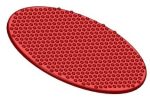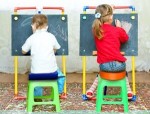A study by Sarver et al. (2015) has found that children with ADHD performed better on tasks that require concentration when they sat in a swivelling chair. However, for typically developing children, the opposite was true in that the more they moved the more poorly they performed. The authors believe that allowing ADHD children to move increases their alertness as it ‘wakes up’ the nervous system (i.e., it has a similar effect to taking medical stimulants). The difficulty from a teaching or parent perspective is getting the formula correct – too much movement can also have a detrimental effect and become distracting.
Below are some different items that can be used to provide sensory stimulation. Remember, a fidgeting child is often more of an issue for parents and teachers than it is for the child.
Ideas for Fidgety Kids

Does your child really need to stand to complete the work? It is often useful to alternate between the child sitting and standing to complete the work. The kitchen bench is often an ideal height for older children or the kitchen table for younger children. If it is an activity they can complete on a white board you could use a standing white board or stand a portable white board on a stand of (if you’re brave) you can have your child write on the fridge (just check first to make sure the markers you use can be rubbed off).
Hokki Stools – backless stools that allows kids to sit and wiggle.

Fit balls are a cheaper options.

Fidget toys such as “squeeze balls”.

Weighted laps mats or use a draft stopper (remove the stuffing and fill with rice).

Dis-o-sit cushions.
Sensory vibration cushions.

Sensory seat tactile mats.
Many of these products are available from Skill Builders: http://www.skillbuilders.com.au/
Reference
Sarver, D.E., Rapport, M.D., Kofler, M.J., Raiker, J.S., & Friedman, L.M. (2015). Hyperactivity in attention-deficit/hyperactivity disorder (ADHD): Impairing deficit or compensatory behaviour? Journal of Abnormal Child Psychology, 43 (7), 1219-1232.


